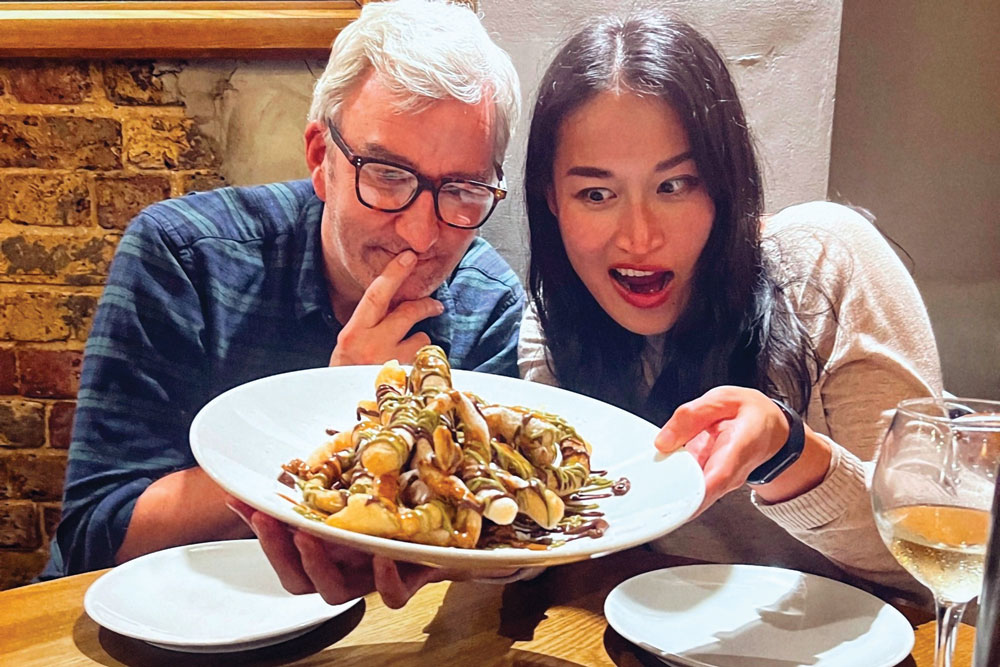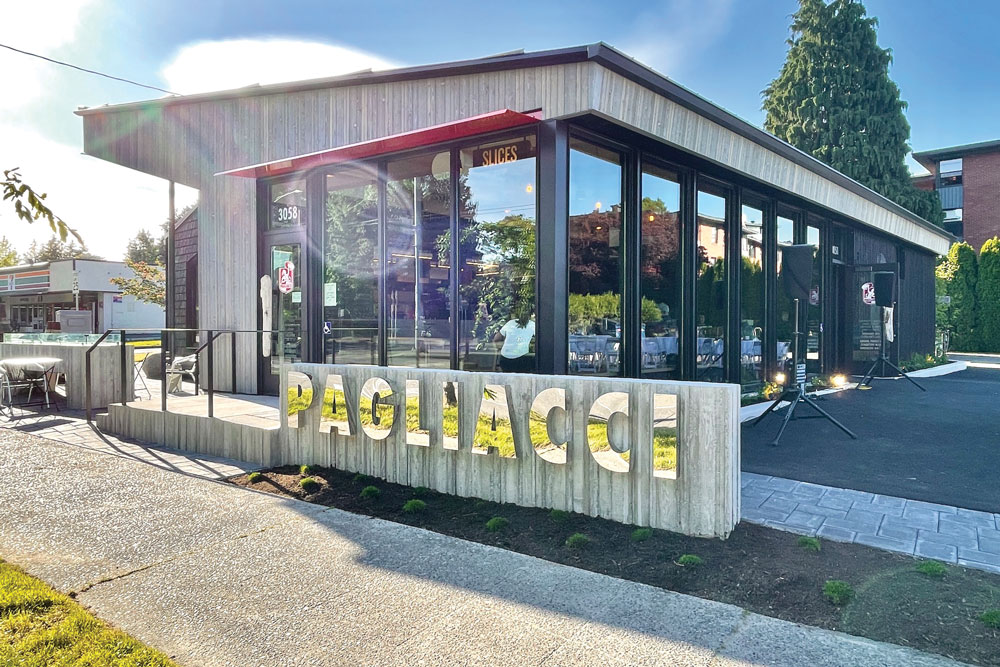By Charlie Pogacar
In many ways, pizza is going back to its roots. Once a street food in Naples, Italy, pizza spent more than a century being domesticated, with brick-and-mortar locations pumping out the vast majority of pies on the market. While that type of pizza business isn’t going anywhere anytime soon, new pizza oven technology has allowed up-and-coming pizza makers to more easily take their show on the road.

Richard Payne, the acclaimed pop-up artist behind Dough and Behold in London. (Photo courtesy Dough and Behold.)
Take, for example, Richard Payne, a pop-up pizza artist from London, who has a day job that has nothing to do with pizza. If you’ve ever watched Peaky Blinders, you’ve seen something Payne worked on—he’s an award-winning post-production video editor by day. At night, Payne can be spotted at local haunts, firing up his portable pizza oven to cook for the masses. His business is called Dough and Behold, and it has amassed more than 36,000 followers on Instagram.
Payne had long experimented with making bread at home and became infatuated with dough in particular. After years of baking bread, he began experimenting with cooking pizza on a clay stone in his home oven. In 2016, he got his first Ooni oven as a birthday present and began baking outside, in his garden. “When I made my first pizza in that oven, it was honestly, truly terrible,” Payne says. “But it absolutely destroyed anything I’d ever made before that. It was like a shaft of light coming down from heaven. From that point on, I knew I’d never go to another shop and buy a branded pizza to reheat in the oven. From that point on, I was addicted to pizza.”
Payne’s first pop-up happened in an unlikely setting. There was an upcoming Christmas fair at the school attended by his daughter, Emily, who was 10 years old at the time. The community was invited to set up tables and sell arts, crafts and the like. Payne figured, “Well, I’ve gotten pretty decent at this pizza thing—maybe I’ll try doing that.”
It was at this point that Payne realized he needed a name and an Instagram handle. After a little experimentation with wordplay, he eventually came up with Dough and Behold (@dough_and_behold on Instagram), and the name stuck.
“It doesn’t take too long to get to know your [oven]. If you have a solid dough recipe, you just need maybe 10 to 15 bakes to find the hot and cold points.”
—Richard Payne, Dough and Behold
Payne admits now that he had no idea what he was getting himself into when he signed up for that Christmas fair. He gives this advice to anyone looking to parlay a portable pizza oven into a moneymaking opportunity: Get your process down first. And don’t try to do it alone. That’s what Payne did, and soon he had a line of 50 hungry people snaking outside his booth. Fortunately, his intrepid daughter came to the rescue. When Emily could have been hanging out with friends and exploring the Christmas fair, she hopped behind the counter and began stretching dough for Payne. “That remains one of my favorite memories as a parent,” Payne recalls. “And that pop-up also cemented that this was something we wanted to keep pursuing. It gave Dough and Behold a purpose, if you will.”
Related: Pop culture: How to create a pizza pop-up event
Payne kept honing his craft, and, as he did, he received more and more attention on Instagram. That gave him confidence to continue pursuing pop-ups during his nights and weekends. It also meant he was forging online connections with a number of other pizzaioli around the world. He eventually got connected with a group who dubbed themselves the Pizzaiolo Tribe. The crew, which includes other renowned pizza makers with strong social media followings, regularly meets online to network and compare notes—and the pandemic only strengthened those connections.
Payne now makes decent side cash with his pop-ups at local venues. He is sometimes a guest chef at Base Face Pizza in London and was named an Ooni ambassador, which means he has experimented with just about every type of portable pizza oven you can imagine. He says the rate at which the ovens are evolving is staggering—and mastering them isn’t all that hard once you know what you’re doing. “It’s a pretty steep learning curve,” Payne says. “It doesn’t take too long to get to know your Ooni. If you have a solid dough recipe, you just need maybe 10 to 15 bakes to find the hot and cold points. It’s just like any pizza oven, really, in that it has its own quirks.”
Payne was especially impressed to realize he could cook virtually any pizza style with a portable pizza oven. The temperatures get as high as 950°F, and the ovens can accommodate different types of pans. “Any style you want to explore, these ovens can do it,” Payne says. “In the U.K., we weren’t previously as influenced by U.S. pizza. Being closer to Italy, everyone wanted to do true Neapolitan pizza. Now, so many people are trying New Haven style, New York style, you name it.”
Learning From the Dough

Feng Chen of Leopard Crust: “I feel that it was the dough that schooled me on how to make pizza.” (Photo courtesy Leopard Crust.)
Feng Chen, based in Bangkok, is another international pop-up pizza maker on the rise. She began around the same time as Payne, and the two are quite close—they get together whenever Chen is in London. Her Instagram account, @leopardcrust, has nearly 60,000 followers, and she also shares her pizza knowledge on her blog, called Leopard Crust Pizza.
Chen specializes in sourdough-crust Neapolitan pies. She first tried a portable pizza oven after borrowing a Roccbox from her friends at Sarnies, an acclaimed Bangkok-based restaurant. “I was blown away by the restaurant-quality pizza such a compact oven could produce,” Chen says. “My first few pizzas weren’t very good, but they were enough to get me hooked on the process.” Eager to improve, Chen says she made pizza every single day at home for two straight years, ate each one and took detailed notes about the dough she had made and the oven conditions she’d used. “It was a very rewarding process, including the necessary hiccups,” Chen says. “While some might say I was self-taught, I feel that it was the dough that schooled me on how to make pizza.”
Like Payne, Chen says that the only way to really perfect the pizza pop-up is to go through the experience of doing it. Dough management, in particular, can be a tricky thing to master if you’ve only ever made pizza indoors and you suddenly find yourself at an outdoor venue with a line of people who are ready to eat. Memorably, Chen’s first pop-up was executed in 100° weather in an open-air space with two Roccboxes running at full blast.
“More often than not, the space I’ll be making pizza from isn’t optimized for a pizza workflow—so solving for that is all part of the fun.”
—Feng Chen, Leopard Crust
“It was critical to keep close tabs on the dough to prevent overproofing, while also preventing yourself from overheating,” Chen says. “In extreme conditions like that, I have to tweak my dough schedule to ensure its window of use matches customer demand. The goal is to change the process to suit the conditions without compromising on the end result.”

Payne and Chen are good friends who get together and talk pizza whenever Chen travels to London. Photo courtesy Dough and Behold.
There are many other things to consider when running a pop-up, especially since not every venue will be ideal for pizza making. But Chen relishes the challenge. “Doing something different each time requires staying open to new ideas and being ready to adapt,” she says. “More often than not, the space I’ll be making pizza from isn’t optimized for a pizza workflow—so solving for that is all part of the fun.”
More than anything, this new generation of portable pizza ovens has lowered the barrier to entry to get into the pizza cooking game. Many of the ovens mentioned above sell for a few hundred dollars—and the burden of learning the craft lies with you, the pizza maker. But, as Chen and Payne can attest, the sky’s the limit. “Having a portable pizza oven is the lowest-cost way to get started [in the pizza business],” Chen says. “The portability of these ovens also means you can set it up anywhere. You don’t need a brick-and-mortar location to start selling pizza.”
Charlie Pogacar is PMQ’s senior editor.













